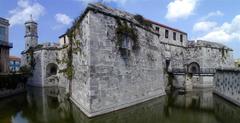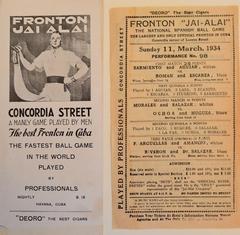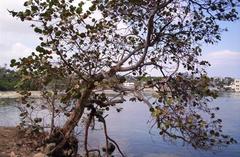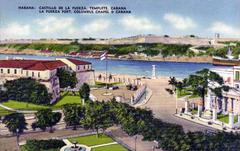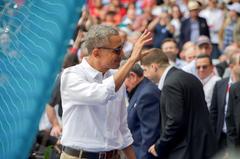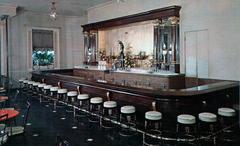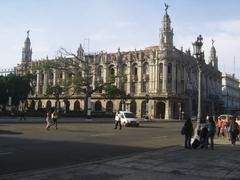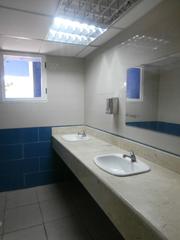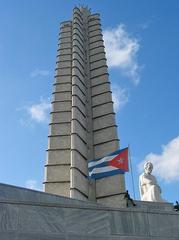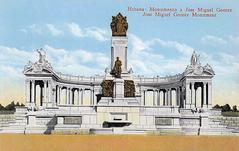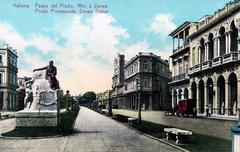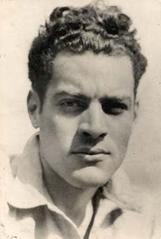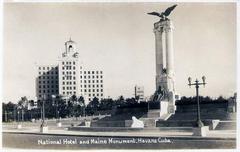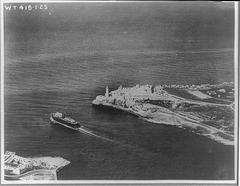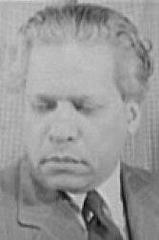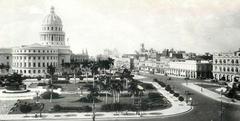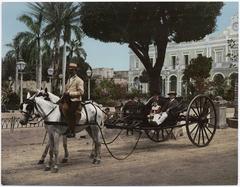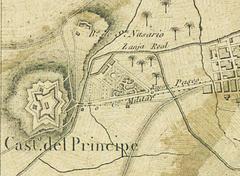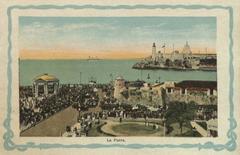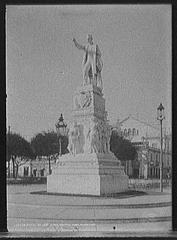
Christ of Havana: Visiting Hours, Tickets, and Historical Significance in Havana Province, Cuba
Date: 04/07/2025
Introduction
The Christ of Havana (Cristo de La Habana) stands as a monumental symbol of faith, artistry, and Cuban identity, overlooking Havana Bay and the city skyline. Erected in the politically charged 1950s, this statue is not only a striking piece of art but also a testament to the island’s cultural resilience and layered history. Whether you are a history buff, art lover, or traveler seeking authentic Cuban experiences, the Christ of Havana offers panoramic vistas, deep spiritual resonance, and a gateway to nearby historical treasures. This comprehensive guide details everything you need to know about visiting the Christ of Havana, including its history, cultural significance, visiting hours, ticket information, accessibility, travel tips, and nearby attractions.
For more insights and travel planning, consult Atlas Obscura, Cuba Travel, and Lonely Planet.
Table of Contents
- Historical Background
- Visiting the Christ of Havana
- Artistic Symbolism and Cultural Importance
- Travel Tips and Practical Information
- Frequently Asked Questions (FAQ)
- Conclusion and Call to Action
- References
Historical Background
Origins and Commissioning
Commissioned in the early 1950s by Marta Fernández Miranda de Batista, wife of President Fulgencio Batista, the Christ of Havana was intended as a gesture of gratitude following an assassination attempt on Batista’s life. The statue was envisioned as a counterpart to Brazil’s Christ the Redeemer, symbolizing peace and protection over Havana during a period of social and political upheaval (Atlas Obscura).
Design, Construction, and Artistic Details
Renowned Cuban sculptor Jilma Madera, winner of a national contest in 1953, designed the statue. The Christ of Havana was carved from 67 blocks of fine Carrara marble in Rome and blessed by Pope Pius XII before shipment to Cuba. The statue stands 20 meters tall on an 8-meter pedestal, making it visible across Havana, especially from the Malecón and Old Havana. Christ is portrayed with a hand raised in blessing, the other on his chest—his gaze directed over the city as a symbol of protection. Some locals note unique features: parted lips as if about to speak or smoke a cigar, and flip-flops, reflecting Cuban culture and the artist’s personal touch (Atlas Obscura).
Inauguration and Revolutionary Aftermath
Inaugurated on December 24, 1958, the statue’s unveiling was soon overshadowed by the Cuban Revolution, which reached Havana days later. The Christ of Havana thus stands at the crossroads of Cuba’s modern transformation—intended as a symbol of religious faith, it became an enduring witness to the nation’s changing tides (Cuba Travel).
Neglect, Restoration, and Rediscovery
Post-revolution, the statue was neglected amid religious suppression, its marble surface overtaken by vegetation and its location restricted within a military zone. In the 1990s, as Cuba reopened to tourism and relaxed religious restrictions, the Christ of Havana was restored and re-embraced as a cultural icon. A major restoration in 2013 restored its original splendor, earning the National Restoration Prize (Atlas Obscura).
Visiting the Christ of Havana
Visiting Hours and Tickets
- Opening Hours: Daily from 8:00 AM to 6:00 PM.
- Tickets: Entry is free of charge; donations for maintenance are welcome.
Accessibility and Getting There
The statue is located in the Casablanca neighborhood atop La Cabaña hill, 51 meters above sea level. Visitors can reach the site by:
- Ferry: Take the scenic “Lanchita de Regla” ferry from Old Havana to Casablanca (10–15 minutes).
- Taxi or Private Car: Through the tunnel under Havana Bay.
- On Foot: A short but moderately steep uphill walk from the ferry or parking area.
While the site is generally accessible, the final approach involves steps and uneven terrain. Visitors with mobility issues may need assistance.
Guided Tours and Highlights
Guided tours offered by local operators often combine the Christ of Havana with nearby attractions such as La Cabaña Fortress and El Morro. These tours provide historical and cultural context, enriching the visitor experience.
The hilltop location offers some of Havana’s best panoramic views—ideal for photography at sunrise or sunset.
Nearby Attractions
- La Cabaña Fortress: An 18th-century fortress hosting museums and the nightly cannon-firing ceremony.
- Castillo de los Tres Reyes del Morro (El Morro): A 16th-century fortress guarding the bay’s entrance.
- Casablanca Neighborhood: Offers an authentic slice of Cuban daily life.
- Old Havana (Habana Vieja): Accessible via ferry, filled with colonial plazas, museums, and vibrant street scenes.
Artistic Symbolism and Cultural Importance
The Christ of Havana fuses European sculptural tradition with Cuban cultural symbolism. Its facial features reflect the nation’s mestizaje (mixed heritage), and local folklore humorously interprets the statue’s gestures as holding a cigar and mojito. The flip-flops modeled after Jilma Madera’s own shoes add a personal story. Despite Cuba’s secular status, the statue is a beloved symbol of hope and national resilience, officially declared a National Monument and often featured in local art and photography (Atlas Obscura).
Travel Tips and Practical Information
- Best Visiting Times: Early morning or late afternoon for cooler temperatures and softer light.
- What to Bring: Water, sun protection, camera, and comfortable shoes.
- Facilities: Basic amenities include a souvenir shop and restrooms; refreshment options are limited.
- Currency: Cash payments in Cuban Peso (CUP) are standard.
- Safety: The area is safe, but remain vigilant and purchase souvenirs only from official vendors.
- Language: Spanish is predominant; some guides and vendors speak basic English.
Frequently Asked Questions (FAQ)
Q: What are the Christ of Havana’s visiting hours?
A: Open daily from 8:00 AM to 6:00 PM.
Q: Is there an entrance fee?
A: No, entry is free.
Q: How do I get to the Christ of Havana?
A: By ferry from Old Havana to Casablanca, taxi, or private car.
Q: Are guided tours available?
A: Yes, many operators offer tours including the statue and nearby sites.
Q: Is the site accessible for people with limited mobility?
A: The approach involves a moderate uphill walk; some assistance may be needed.
Q: What are the best times for photography?
A: Early morning and late afternoon for the best lighting and fewer crowds.
Conclusion and Call to Action
The Christ of Havana is more than an artistic masterpiece; it encapsulates Cuba’s enduring spirit and complex cultural heritage. Its hilltop perch offers not only panoramic views but a vantage point on the nation’s layered past and present. Whether you’re seeking historical insight, cultural symbolism, or simply a breathtaking vista, a visit to the Christ of Havana is an unforgettable experience.
For further tips, up-to-date visitor information, and personalized travel guides, download the Audiala app and follow us on social media. Plan your visit to the Christ of Havana and discover the heart of Havana’s cultural legacy.
References
- Atlas Obscura: El Cristo de La Habana
- Cuba Travel: Christ of Havana
- Lonely Planet: Christ of Havana
- InsightCuba
- The Cuban History
- The Travel Textbook
- Don Knebel
- I Dream of Mangoes



